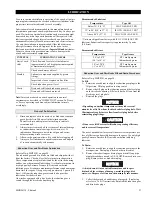
14
MHD56114 - Edition 4
OPERATION
It is recommended that the user and owner check all appropriate
and applicable regulations before placing this product into use.
The four most important aspects of winch operation are:
1.
Follow all safety instructions when operating the winch.
2.
Allow only people trained in safety and operation of this
winch to operate this equipment.
3.
Subject each winch to a regular inspection and maintenance
procedure.
4.
Be aware of the winch capacity and weight of load at all
times.
CAUTION
CAUTION
• To avoid damage to the rigging, the structure supporting the
rigging and the winch, do not “two-block*” the end of the wire
rope.
* Two blocking occurs when the winch wire rope is multi reeved
using two separate sheave blocks which are allowed to come into
contact with each other during winch operation. When this occurs
extreme forces are exerted on the wire rope and sheave blocks
which may result in equipment and or rigging failure.
WARNING
WARNING
• The winch is not designed or suitable for lifting, lowering or
moving people. Never lift loads over people.
Operators must be physically competent. Operators must not have
a health condition which might affect their ability to act, and they
must have good hearing, vision and depth perception. The winch
operator must be carefully instructed in his duties and must
understand the operation of the winch, including a study of the
manufacturer’s literature. The operator must thoroughly
understand proper methods of hitching loads and must have a
good attitude regarding safety. It is the operator’s responsibility to
refuse to operate the winch under unsafe conditions.
Winch Controls
A spring loaded, motor mounted, manual throttle control valve is
supplied as a standard feature on these winches. Optional remote
pendant controls are also available. Reference the model code on
the winch nameplate and compare it to the “SPECIFICATIONS”
section on page 6 to determine winch configuration. The throttle
control provides operator control of the motor speed and direction
of drum rotation.
Operate winch throttle control using smooth, even movements. Do
not slam or jerk throttle controls during operation.
Winch Mounted Control Valve
Refer to Dwg. MHP1809 on page 14.
The spring loaded, live air, manual control valve mounts to rotary
housing.
To operate control valve, place palm of hand on control knob and
wrap fingers around flange of sliding handle. Squeeze fingers,
lifting sliding handle up to unlock control lever. Shift control lever
in desired direction to payout or haul-in wire rope.
As viewed from air motor end, move control throttle handle to the
right (clockwise) to payout wire rope and to the left
(counterclockwise) to haul-in wire rope. Avoid sudden movements
of control valve to ensure smooth operation of winch.
When released, handle will return to neutral or center position.
The sliding handle will drop down to engage and lock control
handle in place.
Winch Mounted Throttle Control Valve Operation
(Dwg. MHP1809)
Remote Mounted Control Valve (optional feature)
Refer to Dwg. MHP2043 on page 14.
Provides for remote mounting of winch control at a fixed location
at up to 20 feet (6 metres) away from winch motor. Air hoses
connect throttle to winch motor to provide winch operation.
Move control throttle handle to the right (clockwise) to payout
wire rope and to the left (counterclockwise) to haul-in wire rope.
Avoid sudden movements of control valve to ensure smooth
operation of winch.
Remote Mounted Control Valve
(Dwg. MHP2043)
Haul-In
Brake Release Port
1/4 NPT
Air Inlet Port
1-1/4 NPT
Payout
Lift Slider
Handle
UP to
Unlock
Exhaust Port
1-1/2 NPT
To Brake
Threaded
Ports
Содержание FA2.5A Series
Страница 38: ...MHD56114 Edition 4 37 SERVICE NOTES...
Страница 70: ...MHD56114 Edition 4 69 SERVICE NOTES...
Страница 71: ...70 MHD56114 Edition 4 SERVICE NOTES...






























